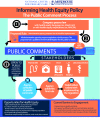Applying a Health Equity Lens to Evaluate and Inform Policy
- PMID: 31308601
- PMCID: PMC6604770
- DOI: 10.18865/ed.29.S2.329
Applying a Health Equity Lens to Evaluate and Inform Policy
Abstract
Health disparities have persisted despite decades of efforts to eliminate them at the national, regional, state and local levels. Policies have been a driving force in creating and exacerbating health disparities, but they can also play a major role in eliminating disparities. Research evidence and input from affected community-level stakeholders are critical components of evidence-based health policy that will advance health equity. The Transdisciplinary Collaborative Center (TCC) for Health Disparities Research at Morehouse School of Medicine consists of five subprojects focused on studying and informing health equity policy related to maternal-child health, mental health, health information technology, diabetes, and leadership/workforce development. This article describes a "health equity lens" as defined, operationalized and applied by the TCC to inform health policy development, implementation, and analysis. Prioritizing health equity in laws and organizational policies provides an upstream foundation for ensuring that the laws are implemented at the midstream and downstream levels to advance health equity.
Keywords: Health Disparities; Health Equity; Policy; Transdisciplinary.
Conflict of interest statement
Competing Interests: None declared.
Figures
References
Publication types
MeSH terms
Grants and funding
LinkOut - more resources
Full Text Sources



